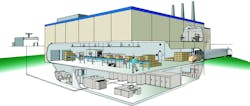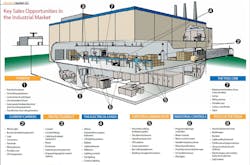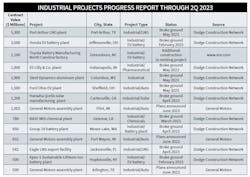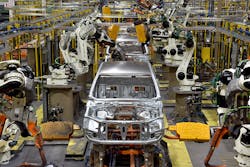From the largest industrial conglomerate in smokestack America to the smallest machine shop in an industrial park a market exists for electrical supplies that accounts for an estimated 32% of all sales through electrical distributors. According to Electrical Wholesaling’s 2023 Market Planning Guide, this market will account for approximately $35 billion in sales through electrical distributors when you count in all the MRO, OEM and factory automation applications for industrial products.
When people think of the industrial market, too often they just think of massive industrial plants — assembly lines building sport utility vehicles; steel plants with huge vats pouring molten steel into forms; or colossal factories cranking out the products that fill the shelves of every Main Street shop or big-box retailer. But a huge portion of the industrial market is in the smaller but more numerous manufacturers that produce products built into other products — the seat covers for that SUV; the machinery that mashes and molds that steel into other products; the packaging for those items on a store’s shelves; and for zillions of other types of products or businesses. Thousands of smaller customers exist in a broad array of industries, including pulp, paper and timber; chemical manufacturing; refinery operations; bottling; packaging; machine-tool building; food processing; military and aerospace products; and heavy industrial and construction equipment.
These industries have an enormous appetite for electrical products such as lighting equipment; wire and cable; fittings; connectors; terminals; conduit and wiring systems; motors and motor controls; hazardous locations equipment; sensors; WiFi network equipment; programmable logic controllers (PLCs); circuit breakers and fuses; switchgear; voice/data/video (VDV) products; power conditioning equipment; signaling equipment; building management systems; machine-vision systems; bar coding equipment; and electricians’ supplies.
Don’t forget some of the new-generation products such as IoT-enabled sensors that monitor manufacturing lines, lighting, WiFi networks, HVAC systems and related building automation networks; LED lighting systems; the products needed for on-site energy generation systems like standby generators, photovoltaic (PV) panels; and natural gas or cogeneration-fueled turbines that produce energy off of the pubic power grid. Check out the illustration below to see how these products might fit into a typical industrial application — and provide a sales opportunity for your company.
Selling a package of products ranging from tiny wire terminals to towering motor control centers and the latest in wireless technology, as well as stocking and talking knowledgeably about the hundreds of related products, is not an easy task. This article provides an overview of the industrial market for newcomers to the electrical wholesaling business, as well as for industry veterans who want to brush up on the basic trends shaping this market or discover new strategies for scaring up industrial sales opportunities.
While the electrical systems are often much larger in industrial facilities than in the commercial market, with a few notable exceptions such as PLCs, industrial sensors and hazardous locations equipment, the products used in the industrial market are in the same basic product families as those used in commercial applications.
One thing about the industrial market has held true over the years — when it’s strong, business can be very, very good for the electrical wholesaling industry. But when your industrial customers are suffering from a dearth of demand for their products and they are not building new production lines or refurbishing existing facilities, business is tough. Over the past few years, the U.S. industrial market has been one of the busiest areas of the entire construction market because of the trend toward onshoring factories and the construction of new factories for electric vehicles and EV batteries (see chart on this page).
The industrial market is a huge part of the U.S. economy, and in some areas of the country it’s doing particularly well, such as in areas where auto manufacturers are building new factories for electric vehicles of ICE (internal combustion engine) vehicles or renovating existing facilities. And when the auto industry is expanding, it also creates sales opportunities in feeder industries. Along with the auto plants themselves, you have hundreds of companies manufacturing equipment for new cars, including tires, seats, headlamps, sound systems and a gazillion other OEM products.
Construction data from the U.S. Census Bureau points toward huge growth in the factories that produce equipment for the computer, electronic and electrical industries. Through May, spending in these areas is up +234.5% to $112.4 billion according to U.S. Census data.
DATA THAT MATTERS
If you want to get a snapshot of the industrial market’s health on a national basis, here are several good economic indicators to track:
- Capacity utilization
Machine-tool orders - Purchasing Managers Index
- Non-defense durable goods orders, excluding transportation
- Manufacturing employment
- Manufacturers’ shipments
- Baker-Hughes rig count (if you are interested in the oil & gas market)
Capacity utilization. This statistic follows manufacturers’ industrial capacity and how much of it is being used. According to the Federal Reserve Board, total capacity utilization was at 78.9% in June 2023, -1.6 points less than in Junee 2022. As rule of thumb, when the capacity utilization number hits 80%, manufacturers will look to expand capacity. Check this website for current data: www.federalreserve.gov/releases/g17/Current/.
Machine-tool orders. The Association for Manufacturing Technology, provides regional and national U.S. orders data of domestic and imported machine tools and related equipment. Analysis of manufacturing technology orders provides aleading economic indicator as manufacturing industries invest in capital metalworking equipment to increase capacity and improve productivity. These machines on the factory floor do the actual shaping, cutting, bending, forming and perform other manufacturing processes.
The most recent data from the association said orders increased +8.6% over April 2023 but fell short of May 2022 orders by -16.7%. Annual orders for 2023 increased to $2.1 billion, nearly -15% behind orders for the same period in 2022. To track monthly data go to www.amtonline.org.
“May orders increased but not enough to make up for the record decline we saw in April,” said Douglas K. Woods, president of AMT, in the press release. “Job shops increased orders at a slightly faster pace than the general market, but many large consumers of manufacturing technology decreased orders for the second month in a row. Significant growth from typically smaller consumers of manufacturing technology highlights some interesting changes in how and where goods are manufactured, particularly in anticipation of government spending programs.”
Interestingly, AMT said orders from manufacturers of electrical equipment are at the highest monthly level of 2023, and that this puts the industry on pace to make the second-largest investment in manufacturing technology since 2018. “Much of the current investment stems from efforts to mitigate strains on the grid caused by unusual weather patterns,” the release said. “However, more investment from this sector may be on the horizon. The Grid Resilience and Innovation Partnership (GRIP) program, part of the 2021 Bipartisan Infrastructure Act, is expected to send notification of approved projects by the summer of 2023, which may spur more investment in manufacturing technology from this industry.”
Manufacturers’ New Orders - Nondefense Capital Goods Excluding Aircraft. In its “FRED” treasure trove of economic statistics, the Federal Reserve Bank of St. Louis offers this report in an easy-to-digest downloadable format through this link: https://fred.stlouisfed.org/series/NEWORDER. The latest data showed that orders in June 2023 of $74,079 million were up +1.9% YOY from $72,732 million in June 2022.
Purchasing Managers Index (PMI). The Institute for Supply Management (ISM), Tempe, AZ, formerly known as the National Association of Purchasing Managers (NAPM), offers a wide variety of statistics on the purchasing activity of manufacturers and service companies on its website, www.instituteforsupplymanagement.org. One of the many useful statistics on this site is the Purchasing Managers Index, which tracks purchasing activity on a national basis, as well as by industry. Many economists rely on this data as leading indicator of future industrial purchasing. Any reading over 50 in the index points toward a healthy purchasing climate. ISM’s Manufacturing PMI has spent the past 12 months under the 50-point mark.
THE BIGGEST MARKET TRENDS
Construction of EV and semiconductor plants. The construction of factories producing semiconductors, electric vehicles and EV batteries. It’s been quite some time since the industrial market has seen a surge in the construction of factories in the auto and computer industries in any way similar to what we now see. Traditional auto manufacturers including Ford, GM, Toyota, Nissan, Hyundai and EV specialists including Tesla, Lucid and Rivian are all investing billion in EV plants, and Panasonic has broken ground on a massive EV battery plant in Kansas. In the semiconductors industry, Intel, Skywater Technology, Global Foundaries, Taiwan Semiconductor, and Texas Instruments are all building new facilities or adding to existing factories.
One measure of the amount of industrial construction is the U.S. Census Dept. monthly data on the Value of Private Construction Put In Place. Through June, it reported $108,819 million in spending of computer/electronic/electrical facilities, a +236.65% increase.
A recent report from the U.S. Treasury Dept. said the financial incentives from the Biden Administration has contributed to a “striking surge” in construction spending for manufacturing facilities. “Today, the computer/electronic segment is the dominant component of U.S. manufacturing construction,” the report said. Importantly, the boom in this segment has not been offset by reduced spending on other manufacturing construction segments, which are largely consistent with long-term levels. In fact, construction for chemical, transportation and food/beverage manufacturing is also up from 2022, albeit much less than the computer/electronic sector.
“This rise in the spending began in the months before the CHIPS Act passed, as many factors beyond policy contribute to construction spending. Still, the legislation has played a critical part in continuing and expanding this trend.”
The report also noted that according to the Semiconductor Industry Association, more than 50 new semiconductor ecosystem projects have been announced in the wake of the CHIPS Act, and also cited a Deutsch Bank report that said 18 new chipmaking facilities will have started construction between 2021 and 2023.
Maintenance, repair and modernization of electrical systems continue to account for about half of all electrical work performed in industrial facilities. New construction of industrial facilities often directly depends on demand for the products that the plant produces. It’s also affected by local or national economic trends and the financial health of that company. As in any new construction market, distributors ride the ups and downs of new industrial facility construction. When the construction of new industrial facilities is hot, the sales potential is huge. But when customers are not building new facilities, distributors must take advantage of the more consistent demand for electrical products needed for the repair, retrofit and modernization of existing buildings.
The nice thing about this market is that it’s seldom as cost-sensitive as new construction work. The gross sales dollars may not be as big, but the profit margins tend to be much higher. Customers need distributors that can react immediately on their demands for repair products, and price is seldom as much of an object when a key assembly line is down because of a malfunctioning electrical component.
A relatively small group of manufacturers produce huge amounts of the products for the industrial market. Full-line distributors aren’t big players in the industrial market unless they stock at least one of the following lines: ABB (which acquired GE Industrial for $2.8 billion in 2018), Rockwell Automation/Allen-Bradley Co., Schneider Electric, Eaton or Siemens. ABB These companies provide not only industrial control and motor-related products, but broad distribution equipment and switchgear packages, too.
Integrated-supply arrangements evolved and survived. A decade ago, you could not pick up an industry publication without reading about a new integrated supply agreement. In these arrangements, noncompeting distributors of industrial, MRO and construction products band together to offer mutual customers a single-supply source for many MRO needs. These integrated-supply partnerships tend to target the largest industrials, but they also work for large companies with multiple facilities such as Fortune 500 companies and utilities.
During the dot-com era, more than a dozen of these groups existed, as dot-com companies from outside the distribution industry, with names like purchasingcenter.com, totalmro.com and equalfooting.com, thought they could replace existing channels of distribution by taking all of this business online.
These dot-com entrepreneurs burned through their venture funding, and many distributors with an interest in integrated supply or national accounts are now part of at least two large groups, each with a slightly different background and focus: Vantage Group, Crystal Lake, IL.; and SupplyForce, King of Prussia, PA. SupplyForce spun off from Affiliated Distributors in 1999 and in 2014 merged with Vanguard National Alliance, Malborough, MA, to provide nationwide support of national contracts for Rockwell Automation distributors.
More electrical contractors are being hired to do on-site maintenance work at manufacturing facilities. This trend has been happening for years because your industrial customers can cut operating costs by farming out their electrical service work. This is an important trend for electrical distributors, because it can change the buying influences. Check with industrially oriented electrical contractors in your market to see if they are involved in this type of work.
As the automation of the factory floor has evolved over the past 30 years, end users have been able to monitor, collect and process unprecedented amounts of information. For years, distributors provided the hardware that made this happen, such as programmable logic controllers, sensors, relays, pilot lights, variable speed drives, enclosures, cabling and related connectors.
But as the need to collect and process this information increased, distributors’ customers began asking for high-speed communications systems to carry information from the factory floor to the corner office, or to other facilities. Along with conventional industrial communications networks constructed of shielded twisted-pair cable, coaxial cable or fiber-optic cabling, IP-enabled sensors and sometimes WiFi networks now send data wirelessly to the cloud over the internet. It’s one example of how the IoT is now changing the electrical market.
It’s no longer enough to just provide the “nuts-and-bolts” for the factory floor. Distributors’ customers are looking for a one-stop solution in supply and software programming. In fact, the software has become such a big part of the sale that products such as PLCs that were once considered the highest of high tech have become commodities.
All the major players in industrial automation have built up their software capabilities. As Electrical Wholesaling reported several years ago, “Manufacturers in the industrial automation space have grasped the potential of building a robust industrial data platform and this year actively positioned themselves through acquisitions and internal structural changes to pursue the industrial IoT (IIoT) as a primary emphasis for future growth. We’re now seeing a high-stakes race among large industrially oriented electrical manufacturers to realize the IIoT’s potential, each seeking to establish a standard software platform for gathering and interpreting data in the manufacturing, process, infrastructure, utility and related industries.”
This trend means that distributors either must have the programming capabilities on staff or partner with companies such as systems integrators that have this expertise. Remote management of an industrial facility’s electrical system over the web helps alert maintenance personnel of blown breakers, power fluctuations, energy usage and dozens of other electrical measurements.
OSHA has gotten more serious about trying to stop electrical accidents on the job. The Occupational Safety and Health Administration (OSHA) continues to enforce its regulations to make industrial plants safer workplaces, and these regulations have created sales opportunities for electrical distributors. The “lockout-tagout” rules require industrial facilities to use specially designed lockout tags to ensure the circuits electricians are working on cannot be inadvertently energized by other workers. Other requirements call for proper signage, GFCI protection of many electrical circuits, and frequent inspection of portable cords to ensure that they are always in safe working order.
New products that do jobs better, faster or at less cost than traditional electrical products will continue to attract customer interest. For instance, IoT-enabled equipment is now a reality; new types of cable tray systems offer customers more options in wiring systems; the move toward modular electrical equipment has increased the demand for multiple-contact connectors; and ever-more efficient lighting systems offer solid ROIs. They offer real-world benefits to your customers — and provide a solid sales opportunity.
WHAT IT TAKES TO WIN IN THIS MARKET
With these fast-changing trends, as well as the overwhelmingly technical nature of many of the products, the industrial business can quickly become quite confusing for newcomers to the electrical industry or the industrial market. Don’t despair. The following basic sales strategies have withstood the test of time in the industrial market. You can increase your chances for survival in the industrial jungle by committing to the following basic concepts.
Know thy customer. It all starts with homework. For starters, you must determine a customer’s product needs. That means you have to find out what type of equipment is already installed and who manufactured those products. You also must know which employee or employees have the most impact on the purchasing decision and what these buying influences want from an electrical distributor. Develop a standardized customer profile to help gather the appropriate information.
Know thy competitors. Identify your customer’s primary suppliers, and familiarize yourself with the services, strengths and weaknesses of those competitors.
Know thy stuff. If you don’t really understand the technical basics of the products you sell, travel with a company product specialist, inside salesperson, independent rep or factory salesperson who does. The industrial market is the most technical of all the market arenas in the electrical wholesaling industry, and product expertise is a huge value-added benefit that you must offer the customer.
Experience the applications. There’s no substitute for getting out on the plant floor and learning more about the working environment where your company’s products live. Many of these products are specifically designed for the industrial market’s adverse environments. Knowing the neighborhood can help you make more informed product recommendations and keep your customer in line with the necessary National Electrical Code (NEC) regulations, particularly in the area of hazardous locations. Touring plants on a regular basis will help you keep abreast of any changes in equipment, or upcoming repair, retrofit, modernization or new construction work. If a customer will let you, don some coveralls and spend a full day on the plant floor to check out their world. It will be a great opportunity to familiarize yourself with the electrical system, meet the plant personnel and get a feel for the flow of how things work. The customer will usually appreciate your interest.
Be there or be square. Service sells in this market, because the cost of a malfunctioning assembly line can be measured in thousands of dollars per minute. If your company is in the MRO market, it isn’t a player unless it offers 24-hour emergency service and delivers on its promises to keep salespeople accessible through cell phones, texts, e-mail, and all other modern and not-so-modern tools of communication.
Build sales by helping customers save energy — and cold cash. The potential cost-savings of energy-efficient products hits home in the industrial market. Energy-efficient lamps, lighting controls and related lighting equipment; variable-speed drives; energy-efficient motors; PLCs and power-monitoring equipment can slash operating costs for your customers.
Offer your customers regulatory relief. As mentioned earlier, OSHA and NEC regulations often create sales opportunities for electrical distributors. On your plant tour, check to see if the present electrical system and any planned modernization fall under the classification system in the NEC’s Chapter 5 for hazardous locations. And while on that tour, don’t forget to look for applications for lockout-tagout devices, signage or new portable cords so you can save your customer a headache or two when confronted by an OSHA inspector.
About the Author
Jim Lucy
Editor-in-Chief of Electrical Wholesaling and Electrical Marketing
Jim Lucy has been wandering through the electrical market for more than 40 years, most of the time as an editor for Electrical Wholesaling and Electrical Marketing newsletter, and as a contributing writer for EC&M magazine During that time he and the editorial team for the publications have won numerous national awards for their coverage of the electrical business. He showed an early interest in electricity, when as a youth he had an idea for a hot dog cooker. Unfortunately, the first crude prototype malfunctioned and the arc nearly blew him out of his parents' basement.
Before becoming an editor for Electrical Wholesaling and Electrical Marketing, he earned a BA degree in journalism and a MA in communications from Glassboro State College, Glassboro, NJ., which is formerly best known as the site of the 1967 summit meeting between President Lyndon Johnson and Russian Premier Aleksei Nikolayevich Kosygin, and now best known as the New Jersey state college that changed its name in 1992 to Rowan University because of a generous $100 million donation by N.J. zillionaire industrialist Henry Rowan. Jim is a Brooklyn-born Jersey Guy happily transplanted with his wife and three sons in the fertile plains of Kansas for the past 30 years.



